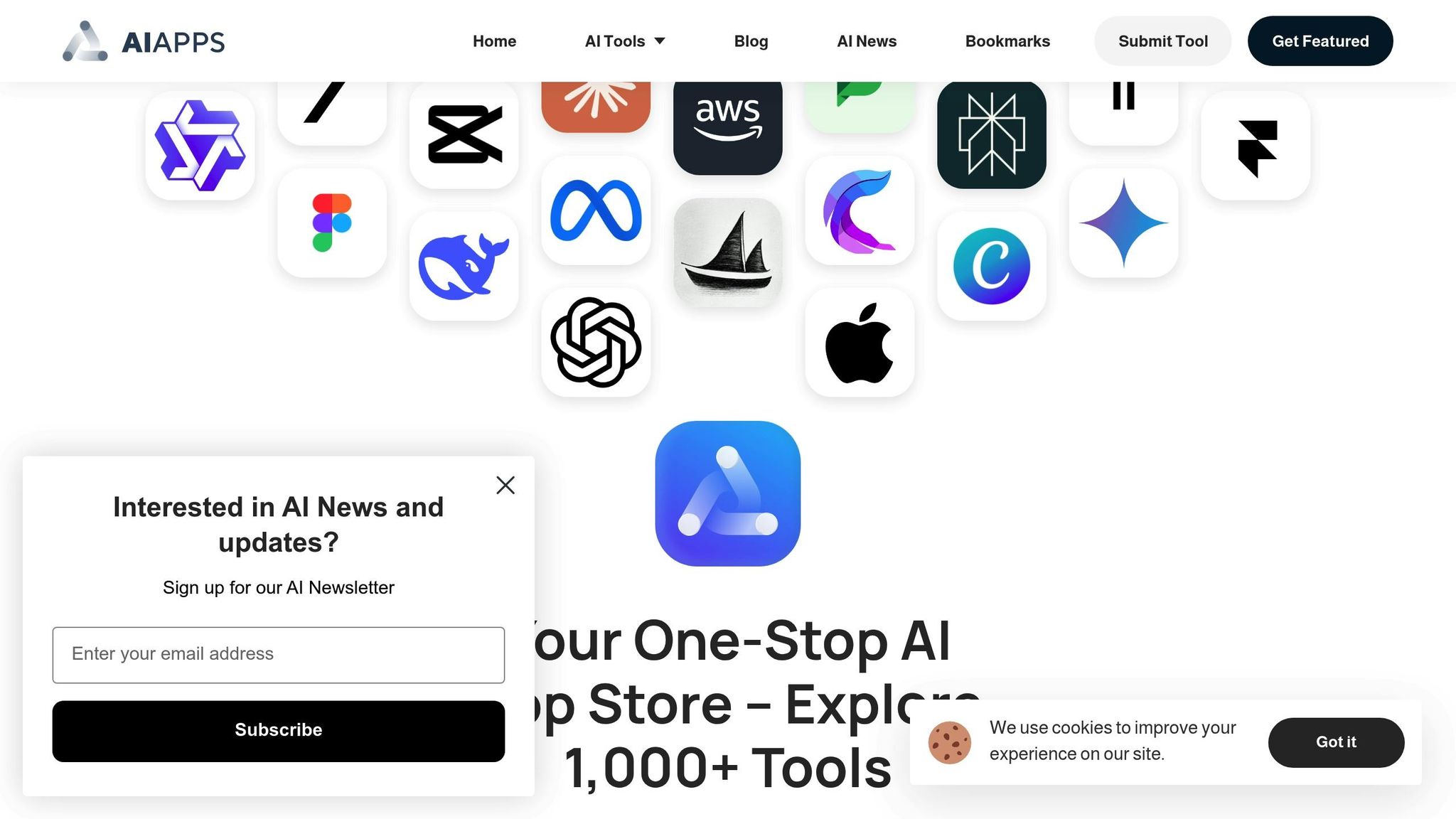Want to save time and boost your marketing results? AI tools can automate tasks, analyze data, and personalize customer experiences. But picking the right tool can feel overwhelming. Here's a quick guide to help you choose:
- Set Clear Goals: Know what you want to achieve - content creation, lead generation, or customer engagement.
- Identify Challenges: Pinpoint your pain points, like time-consuming tasks or lack of data insights.
- Focus on Features: Look for tools with content creation, automation, and analytics capabilities.
- Check Integration: Ensure the tool works with your current systems (e.g., Salesforce).
- Compare Costs: Match pricing to your budget - free tools, subscriptions, or custom solutions.
- Prioritize Security: Choose tools with strong data protection (e.g., GDPR compliance).
- Test Before Buying: Use free trials to evaluate ease of use, features, and performance.
Quick Comparison Table:
| Criteria | Questions to Ask |
|---|---|
| Functionality | Does it solve your top challenges? |
| Integration | Is it compatible with existing platforms? |
| Ease of Use | Is it simple for your team to adopt? |
| Support Options | What training and help are available? |
| Security | Does it meet compliance standards? |
| Cost Structure | Is the pricing reasonable for your needs? |
Key Stats:
- 88% of marketers say AI tools are essential.
- 95% report AI saves time by reducing manual tasks.
- 68% of marketing leaders see ROI from AI investments.
Pro Tip: Use directories like AI Apps to find tools tailored to your needs. With over 1,000 verified options, you can compare features, pricing, and integrations in one place. Start with clear goals, test tools thoroughly, and blend AI with human creativity for the best results.
Choosing the Right AI Tools - with Katie Robbert
Set Your Marketing Goals
Start by setting clear marketing objectives. 68% of marketing leaders already report seeing ROI from their AI investments.
Identify Your Key Marketing Challenges
Pinpoint the biggest hurdles your marketing team faces. 95% of marketers say AI tools free up time by reducing manual tasks, allowing them to focus more on connecting with customers.
| Marketing Area | Common Challenges | How AI Can Help |
|---|---|---|
| Content Creation | Writing and editing take too long | Simplifies drafting and editing |
| Customer Engagement | Lack of personalization | 77% use AI to create tailored content |
| Data Analysis | Difficult to interpret data | 44% report "very effective" results |
| Task Automation | Repetitive, manual work | Saves over an hour daily for 86% |
Mike Maynard, CEO of Napier, sheds light on AI's role in marketing:
"AI will inevitably replace certain aspects of traditional marketing, but by and large, it will probably be the tedious, mundane tasks, like analytics, that most of us aren't enthusiastic about anyway."
Use these insights to ensure your tools address your specific marketing needs.
Choose Tools That Align With Your Goals
Once you've identified your challenges, select AI tools that match your objectives. Here are some strategies:
-
Focus on Time-Consuming Tasks
A majority - 75% of marketers - leverage AI to reduce time spent on repetitive work. -
Identify Skill Gaps
As Mike Maynard puts it:"When used effectively in combination with other tools and skills of our respective teams, the door is wide open for possibilities. I would encourage folks to look at AI as an assistive tool in their digital toolbox."
-
Set Clear Metrics for Success
Metrics are essential, as highlighted by industry insights:"Metrics play a vital role in AI as they allow us to evaluate how well algorithms and models perform in different areas, such as marketing and advertising."
Focus on tools that not only streamline your workflow but also provide personalized customer experiences, ensuring they align with your team's strengths and marketing goals.
5 Key Factors When Choosing AI Marketing Tools
Here’s what to keep in mind when selecting the right AI marketing tool for your business.
Focus on Features That Solve Problems
Look for features that address your specific marketing needs. Some useful capabilities include:
- Content creation and optimization tools
- Customer behavior analysis to understand trends
- Campaign automation for efficiency
- Personalization options to tailor user experiences
- Performance tracking dashboards to monitor metrics
Also, check how well the tool integrates with your current systems to maintain a smooth workflow.
Assess Integration Capabilities
The tool's ability to connect with your existing platforms can make or break its effectiveness. For example, a tool that integrates with Salesforce allows direct access to social data, speeds up case resolutions, and enables personalized interactions.
Compare Costs and Pricing Models
Once you’ve ensured the tool meets your needs, compare pricing to find an option that fits your budget. Here's a quick breakdown:
| Pricing Type | Cost Range | Best For |
|---|---|---|
| Custom Solutions | $6,000 - $500,000+ | Large enterprises |
| Third-party Software | $0 - $40,000/year | Small to medium businesses |
| Consulting Services | $200 - $350/hour | Specialized projects |
Evaluate Scalability
Scalability is essential for long-term growth. Look for tools that can grow with your business, whether that means handling more users or expanding functionalities. Cloud-based platforms often provide flexible, pay-as-you-go scaling options, making them a practical choice for many businesses.
Prioritize Security Standards
Don’t overlook security. Make sure the tool adheres to regulations like GDPR and CCPA. Features to look for include:
- End-to-end encryption to protect data
- Regular security audits to identify vulnerabilities
- Compliance certifications for added assurance
- Data backup and recovery to prevent losses
These factors will help you choose a tool that’s not just effective but also secure and scalable.
sbb-itb-212c9ea
Tool Selection Checklist
Required Features List
Start by identifying the must-have features that will address your biggest marketing challenges.
-
Core Features Assessment
Prioritize these key marketing capabilities based on your needs:- Tools for creating and optimizing content
- Automation features for campaigns
- Dashboards for analytics and reporting
- Customer segmentation tools
- Compatibility with your current marketing platforms
-
Technical Requirements
Consider these technical aspects to ensure the tool fits into your workflow:- API access
- Storage capacity
- User access controls
- Mobile-friendly functionality
- Options for exporting data
Use this list to evaluate and compare potential tools effectively.
Create Tool Comparison
Once your requirements are clear, use them to assess each tool objectively. Here’s a quick guide:
| Evaluation Criteria | Questions to Ask |
|---|---|
| Functionality | Does it solve your top 3 challenges? |
| Integration | Is it compatible with your existing tools? |
| Ease of Use | How easy is it to learn and use? |
| Support Options | What training and help resources are offered? |
| Security | Does it meet necessary compliance standards? |
| Cost Structure | Is the pricing within your budget? |
Try Before Buying
Make the most of your trial period by following these steps:
-
Define Testing Goals
Set clear objectives to evaluate, like the quality of content output or ease of automation. -
Involve Key Users
Bring in team members who will use the tool daily to gather their insights. -
Evaluate Performance
Test the tool’s critical features, observe how it performs, and document any limitations you encounter.
This hands-on testing will help ensure you pick the right tool for your needs.
Using AI Apps to Find Tools

After defining your key selection criteria, AI Apps offers a customized directory to help you find marketing tools that fit your needs. This directory simplifies the process by organizing over 1,000 tools into clear categories.
AI Apps Tool Directory
The AI Apps directory focuses on tools designed for marketing, neatly sorted by their function. You can use advanced filters to narrow down your options based on:
- Marketing Functions: Examples include content creation, social media management, and analytics.
- Pricing Models: Choose between free tools, subscription plans, or pay-as-you-go options.
- Integration Capabilities: Check for API access and platform compatibility.
- Tool Categories: Includes writing assistants, automation platforms, and design solutions.
Here’s how the directory breaks down:
- 373 marketing tools
- 301 visual design tools
- 273 content creation tools
- 197 text summarization tools
- 186 image generation tools
This well-organized structure makes it easier to find the tools you need with minimal effort.
Why Use AI Apps
AI Apps provides several advantages for marketers looking to streamline their workflows:
- Simplified Search: With categories and advanced filters, you can quickly find tools tailored to your specific role and budget.
- Reliable Options: Every tool in the directory goes through a thorough verification process to ensure quality and dependability.
- Time-Saving Features: Stay updated on the latest trends with highlighted tools and new additions. Plus, you can compare features and pricing all in one place.
| Search Criteria | How It Helps |
|---|---|
| Task Type | Locate tools for specific marketing tasks |
| Job Role | Identify tools that align with your responsibilities |
| Price Range | Stick to your budget |
| Integration Needs | Ensure tools work with your current systems |
With these features, AI Apps makes it simple to discover and choose the best tools for your marketing goals.
Conclusion
Using the right AI marketing tools can significantly boost both your marketing effectiveness and ROI. In fact, marketers using AI tools report saving an average of 2 hours and 24 minutes every day.
Here are a few things to keep in mind:
-
Data Quality Is Key: Poor data quality can cut into efficiency by 15–25%. Scott Schober, President/CEO at Berkeley Varitronics Systems Inc., puts it best:
"The quality of your data output is determined by the quality of your data input."
- Thoughtful Implementation Matters: While many marketers see AI as essential for meeting customer expectations, they’re only utilizing about 56% of the tools they purchase. This highlights the need for careful tool selection and proper integration into workflows.
-
Don’t Skip the Human Element: Irina Maltseva advises:
"Don't just use AI tools as a quick fix - blend them into your overall workflow. AI should give you insights, but it's your human touch that makes the content engaging and authentic."
AI Apps simplifies the process of finding the right tools. With a directory of over 1,000 verified options and an advanced filtering system, it helps you match tools to your goals, budget, and technical needs.
To make the most of AI in marketing, focus on strong data, clear objectives, and regular refinement. With resources like AI Apps and a thoughtful approach, you’ll be set to choose tools that elevate your marketing efforts and deliver results.
FAQs
How can I make sure the AI tool I choose works seamlessly with my current marketing platforms?
To ensure the AI tool integrates smoothly with your existing marketing platforms, start by confirming its compatibility with your CRM, ad platforms, and analytics tools. Look for options that support API integration to connect easily with your current systems.
Additionally, decide whether a cloud-based or on-premises solution aligns better with your business needs. Cloud-based tools usually offer more flexibility and scalability, while on-premises options can provide greater control and security. Taking these steps will help you select a tool that fits seamlessly into your marketing ecosystem.
What security features should I prioritize in an AI marketing tool to protect customer data?
When choosing an AI marketing tool, prioritize features that ensure robust data security and compliance. Look for tools that offer data encryption to protect information both in transit and at rest, and ensure they comply with key regulations like GDPR and CCPA. Verify that the tool has strong access controls, so only authorized personnel can access sensitive data.
Additionally, consider tools with clear data ownership policies and retention practices to ensure your organization maintains control over customer information. It’s also important to evaluate the security of any third-party integrations and confirm the tool has an incident response plan to address potential breaches quickly and effectively.
How can I evaluate the ROI of an AI tool for my marketing strategy before committing to it?
To evaluate the ROI of an AI tool for your marketing strategy, start by defining clear objectives, such as increasing sales, improving customer engagement, or reducing costs. Set measurable targets to track progress. Next, calculate the total costs, including upfront investment and ongoing expenses, and estimate the potential financial benefits, like increased revenue or cost savings.
Use the formula ROI = (Net Profit / Investment Cost) × 100 to quantify the return. Additionally, consider intangible benefits, such as enhanced customer satisfaction or improved brand reputation, and account for any risks or uncertainties. Testing the tool on a small scale before full implementation can also provide valuable insights into its effectiveness.



